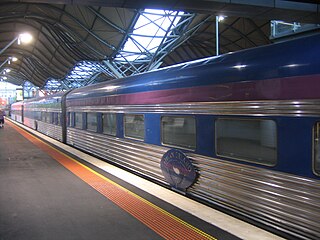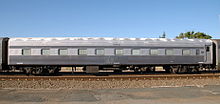Design
| Sitting cars (AJ, BJ, RBJ & CCL) | |
|---|---|
| Constructed | 1950-1970 |
| Number built | 16 |
| Fleet numbers | 1-3AJ, 1-10BJ, 1-3RBJ, Club Car No.1-3, 1-3CCL |
| Capacity | 48 1st class passengers (AJ) 64 2nd class passengers (BJ) 34 2nd class passengers (RBJ) 43 1st class passengers (Club Car/CCL) |
| Specifications | |
| Weight | 48.35 long tons (49.13 t) (AJ) [1] 45.7 long tons (46.43 t) (BJ) [2] 45.1 long tons (45.82 t) (RBJ) [3] 42.25 long tons (42.93 t) (CCL/Club Car) [4] |
| Sleeping Cars (Named, later SJ, JRA, JRB, JTA, JTB, BMC, RZEY, QCAY, CDAY, ADFY) | |
|---|---|
| Constructed | 1949-1972 |
| Number built | 22 |
| Number preserved | 4 |
| Fleet numbers | Allambi, Chalaki, Dorai, Juki, Kuldalai, Malkari, Mokai, Mururi, Nanjuri, Nomuldi, Paiti, Purpawi, Tantini, Tarkinji, Tawarri, Weroni, Yankai, Yanni, Sleeping cars No.11-14, SJ281-284, JRA 1-6, JRB 1 & 2, JTA 1-6, JTB 1-4, Sir Hans Heysen, Sir John Forrest, |
| Capacity | 20 sleeping passengers, either Roomette or Twinette style. Twinette cars could seat 30 passengers in 'day mode'. |
| Specifications | |
| Weight | 52 long tons (52.83 t) [5] |
| Guard and Power Vans | |
|---|---|
| Constructed | 1970-1972 |
| Number built | 6 |
| Number in service | 4 |
| Fleet numbers | 1-2CO, 1-4PCO, PCJ491-493 |
From 1949 The Overland moved into the modern era, with new air-conditioned Corten steel carriages gradually entering service, in maroon with a fluted stainless steel panel on each side and a black roof. The construction style had previously been introduced with the Cafeteria Car, built in 1947 for the Port Pirie region's East-West Express.

The Overland is an Australian passenger train service between Melbourne and Adelaide. It first ran in 1887 as the Adelaide Express, but has been called the Melbourne Express by South Australians. It was given its current name in 1926. Now operated by private company Great Southern Rail, the train completes two return trips a week covering 828 kilometres between the state capitals. Originally an overnight train, it now operates during the day.
Contents
- Design
- Construction
- Phase one
- Phase two
- Phase three
- Phase four
- Operations
- V&SAR era 1949-1975
- V&ANR era 1975-1997
- GSR era 1997-2010
- Current status
- Fleet Details
- First Class Sitting - AJ
- Second Class Sitting - BJ
- Second Class Sitting with Buffet - BRJ
- Club cars
- Sleeping cars
- Power vans
- Luggage vans
- Model railways
- HO Scale
- References
The maroon livery remained until the 1990s.
The sitting cars were all organised as eight compartments linked to a side corridor, with different fittings as suited to the type. The first-class cars seated 48, and the second-class cars seated 64. The sleeping cars each held 20 passengers, either in ten compartments for two each, connected to a side corridor; or ten compartments either side of a central corridor.















